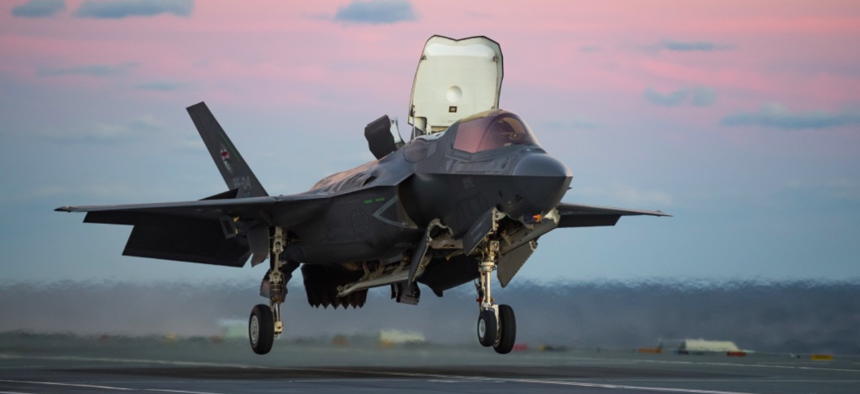
The F-35 Pax River Integrated Test Force tests aboard HMS Queen Elizabeth (R08) for phase two of the first of class flight trials (fixed wing) from British Queen Elizabeth Class carriers. Dane Weidmann
Pentagon’s Focus On China and Russia Expected to Alter US Arms Sales
A new report shows a decline in Middle Eastern nations’ share of overall exports.
As the U.S. military shifts its focus to Russia and China, American arms exports are expected to make a similar shift to allies in Europe and Asia, experts say.
Arms export data already shows a shift away from the Middle East, where Bahrain, Kuwait, Qatar, Saudi Arabia and UAE have been scooping up American weapons.
“I would imagine that this year and next we would see an uptick in sales to Asia, but it hasn’t shown up yet,” William Hartung, director of the Arms Security Project at the Center for International Policy, said Thursday.
The total value of arms-export deals approved by the Trump administration declined from $82.2 billion in 2017 to $78.8 billion last year, according to a new report by Hartung and Christina Arabia, director of the Security Assistance Monitor.
Also declining from 2017 to 2018: the share of deals with countries in the Middle East and Northern Africa, two regions of intense focus in the past two decades of counterinsurgency- dominated wars.
“Deals with countries in the Middle East and North Africa dropped from 36.6% to 21.9%,” the report states. “And offers to East Asia and the Pacific dropped from 23.6% to 14.3%.”
Meanwhile, the share of deals approved for countries in Europe and Eurasia nearly doubled from 29.5 percent in 2017 to 55 percent last year.
“Europe was actually the biggest recipient of new offers in 2018, outpacing the Middle East,” Hartung said. “Some of that may be related to concerns about Russia, although the biggest deal was the $10 billion for Italy to produce F-35s, which is a program that’s been going on for many years.”
He pointed to Slovakia’s purchase of American F-16 fighter jets; Arabia noted the Polish and Romanian orders of U.S.-made missile defense systems.
A number of European nations are currently considering buying Lockheed Martin F-16 or Boeing F/A-18 warplanes.
So why are arms sales down in the Middle East?
“Part of it is just saturation of the market,” Hartung said.
Another key may be the Pentagon’s year-old National Defense Strategy, which prioritizes preparation for great power competition with Russia and China.
Just months after arriving in the White House, Trump announced a $110 billion arms deal with Saudi Arabia that includes warships, helicopters, tanks, bombs and missiles.
“These things take a long time to work through the system and a country is not going to buy fighter planes every year, they’re going to do it periodically,” Hartung said.
Lawmakers have also voiced opposition to selling bombs and missiles to Saudi Arabia and UAE because of civilian deaths in Yemen. The murder of journalist Jamal Khashoggi has also prompted an outcry against Saudi Arabia.
“So much has been sold year after year, after year, it strikes me as perhaps a bit of a pause and not necessarily an indicator of things to come,” Hartung said.
Halfway through fiscal year 2019, the $23 billion arms sales approved by the State Department are lagging behind the pace of the past three years, Roman Schweizer, an analyst with Cowen and Company, wrote in an April 3 note to investors.
“While the Trump administration has made foreign military sales a priority, there could be other Trump foreign and economic policies working against U.S. sales,” Schweizer said. “We have previously expressed concern that President Trump's comments about NATO, France and Germany could encourage those countries to spend more but within their own domestic defense economies rather than on U.S. hardware.”
The government shutdown in December and January may also have partially caused the slowdown.




